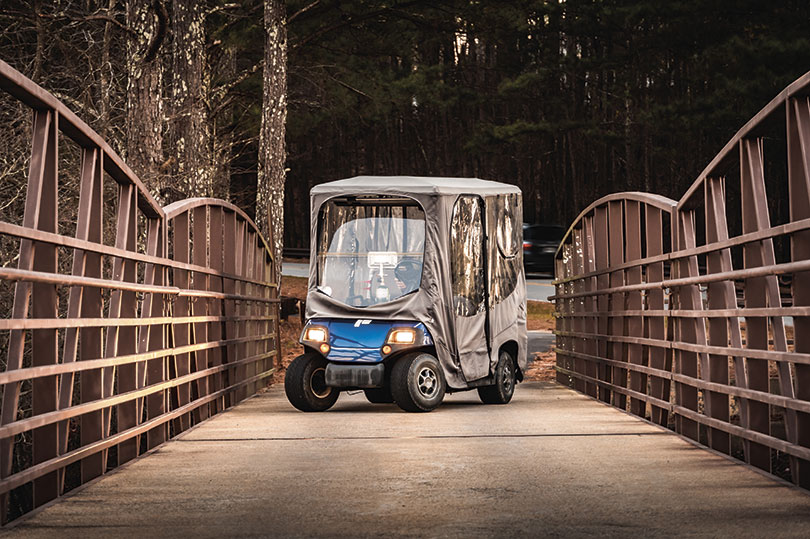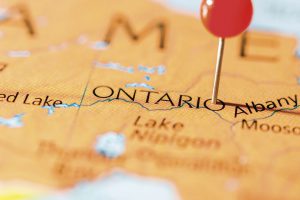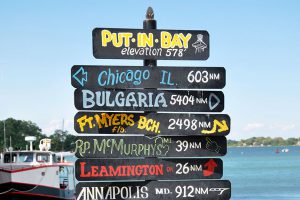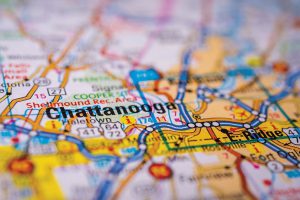
In Peachtree City, Georgia, golf cars are more than just a means of recreation – they’re a way of life. Explore how this unique suburban community has harnessed the power of electric vehicles to create a sustainable and car-lite environment. Could this be a model for the suburbs of the future?
As the school day ends at McIntosh High School in Peachtree City, Georgia, a flood of chattering teenagers flows toward the parking lot, keys in hand. A mini-traffic jam forms as the students hop in their rides and head home. It’s a scene one might encounter at countless high schools across the car-dominated suburbs of the US—except most of these McIntosh students aren’t driving cars, but golf cars.
With about 9,300 golf cars registered among its 13,000 households, this town 31 miles southwest of Atlanta might be the most golf-car-friendly municipality in America. A hundred miles of car-free multi-use paths crisscross the town’s 25 square miles, and many shopping centers and public buildings provide dedicated golf car parking. A cartoon of one of the little vehicles appears on the town’s official logo. “Golf cars really are our identity,” says Mayor Kim Learnard.
Peachtree City has all the familiar trappings of American suburbia, with its single-family homes, space-eating lawns and two-car garages. But its founders also developed a blueprint for a community where driving isn’t a requirement for many daily tasks, decades before the current wave of interest in building walkable communities. It offers a bevy of lessons for developments now emerging on the urban fringe—as well as for existing suburbs and exurbs that are struggling to reduce transportation emissions.
There are other US cities that embrace golf cars as transportation, such as the Villages, a 55-and-older development of more than 80,000 people in Florida that has more than 90 miles of multi-use paths and was engineered around car access from its inception. Numerous so-called golf car communities in the US, such as Sun City, Arizona, and Palm Desert, California, allow carts and cars to mingle on low-speed public roads. But Peachtree City stands alone as an all-ages suburb where golf cars are intrinsic to local life. A visitor can’t help but wonder whether it’s on to something.
Peachtree City’s distinctive mobility approach dates to the town’s founding in the 1950s, when a developer acquired thousands of acres in rural Fayette County. “We went to the edge of urban development, where land was cheap,” says Joel Cowan, who was a 21-year-old junior at Georgia Tech when he read a newspaper article about the project (whose leader happened to be related to one of his fraternity brothers). Cowan leveraged his personal connection to become the fledgling town’s first mayor in 1959. Now 86, he still lives there.
Cowan touted Peachtree City as “Georgia’s New Town,” aligning it with an urban planning movement then popular in both the UK and US that aimed to create comprehensively planned communities that provided place to work, live, and play. Mid-century New Towns, which drew upon the earlier Garden City movement, also appeared in Reston, Virginia; Irvine, California; The Woodlands, Texas; and Columbia, Maryland. Like Peachtree City, many were envisioned with car-free circulation paths.
Most eventually abandoned that model due to land costs and a lack of strong oversight. “You need someone who is coordinating,” says Ann Forsyth, a professor of urban planning at Harvard’s Graduate School of Design, “either a major private property developer who is using those paths as a sales mechanism, or very proactive town governance.” In Peachtree City, Cowan and his colleagues served as both private developers and master planners, giving them the power and incentives to invest in amenities like preserved woodlands, artificial lakes, and multi-use paths.
The first cars appeared in Peachtree City after a golf course opened in the mid-1960s. Early golf-playing residents realized the vehicles were also handy on the town’s multi-use paths. As it grew, Peachtree City expanded its paths and connected them to new subdivisions. To reduce grade crossings with car traffic, the town built tunnels that dipped under major roadways and bridges that rose above them.
In the 1970s, Georgia passed legislation exempting golf cars from state motor vehicle laws, empowering local jurisdictions to establish their own rules. Today, Peachtree City requires residents to register their golf cars and recommends—but doesn’t require—that they obtain insurance. Anyone 16 or older can legally drive one regardless of whether they have a driver’s license, as well as 15-year-olds with learner’s permits. Children can drive with an adult in a front seat with them once they turn 12.
At Peachtree City Golf Cars, a local dealer offering sales, rentals and repairs, new golf cars go for about $13,000 for a four-seater and $16,000 for a six-seater, at most a third the cost of an average new automobile. Most of the town’s golf cars are electric, with owners charging them from a standard outlet in their garage or at public charging stations available at the town library, a local supermarket and other retailers.
Heidi Becker, a local realtor with Keller Williams, says the golf car paths “add to the lifestyle” and push up real estate values in a town that also offers strong public schools and low crime. “Where else can you get on a golf car and go to the gym or go to a restaurant?” she says. Median home sales topped $600,000 in June, well above the median for Fayette County. Money and Realtor.com include Peachtree City on their rankings of the best places to live in the US. Residents talk about how much the cars contribute to the town’s social life. “When you pass people on the paths, you wave and smile,” says Nancy Peltier.
“You may have no clue who those people are, but you still do it.”
More Highlights From the Cities Issue The (Mostly) Empty $100 Billion City How Not to Build Mass Transit The Stuff That Cities Are Made Of A Palestinian Boomtown’s Shaky Peace Local adolescents eagerly await their 15th birthdays so they can independently navigate the town without their parents; Bekah, a junior at McIntosh High School, says having access to a golf car makes it easier to stay late for academic help or after-school activities. And the fender benders that are a regular occurrence in the school’s parking lot are lower stakes than they’d be if the teenage drivers all had cars. Some older residents who might not be able to drive are still able to operate a golf car. “Even if I’d wanted to, I couldn’t fold myself into the car,” says 80-year-old Denny Danylchak, who recently underwent a series of operations that restricted his ability to bend his legs. “But with a golf car I was able to get to the store and get the things I needed.”
A 2007 study from the UK’s Lancaster University suggests that the golf car paths of Peachtree City could help reduce transportation costs and alleviate the social isolation endemic to car-oriented suburban life. The authors surveyed residents and property owners from Peachtree City and concluded that “the effective spatial structure of the car path network and the relative low cost and inherent flexibility of the golf cars combine to reduce transportation-linked social exclusion.”
Still, Peachtree City remains in many ways a typical affluent Atlanta suburb. Public transit service is nonexistent; there are no bus stops in the city, and the nearest Park-and-Ride station is miles away. There’s a reason locals call it the Bubble. The town’s car paths, shrouded in shady trees and foliage, contain minimal signage and seem to be intended solely for the use of residents. Local regulations reflect that: Those living in Peachtree City pay just $15 to register a golf car for three years, but outsiders who want to access its paths must pay $250 annually.
In 2022 tensions over whether the path system should be a private amenity accessible only to residents came to a head when the homeowners association of one affluent neighborhood pushed Peachtree City to close a path connecting it to Tyrone, an adjacent—and somewhat less affluent—jurisdiction. Members of the homeowners association raised concerns about safety and traffic, arguing that Peachtree City’s infrastructure would be further strained as surrounding areas were developed.
Tyrone’s mayor rejected the safety and traffic claims, saying no studies on the issues had been conducted prior to the closure. Learnard also opposed the decision. Her voice rises as she describes the contentious debate, which escalated further in May when the Fayette County Commission voted to authorize a potential lawsuit against Peachtree City in an effort to reopen the path. “That path never should have been closed,” the mayor says. “A path network is not at all about being closed in. It’s about connecting—both within your community and outside of it.”
Peachtree City’s neighboring suburbs are trying to build such connections. Fayette County “is working diligently to expand its network of paths,” its website states, and Tyrone allocated $287,500 to acquire the needed rights of way.
But replicating Peachtree City’s model—a complete, separated system of multi-use paths—in an existing suburb is easier said than done. Much of the value of the town’s network lies in its comprehensiveness, which is only possible because planners expanded it as new developments were built. Adding infrastructure after the fact would likely be expensive and politically fraught, and the effort could be scuttled if even a few property owners refuse to provide easements. And as the situation with Tyrone shows, there’s no guarantee such suburbs would welcome the communities next door.
That doesn’t mean low-speed electric vehicles can’t fit into American suburbs. Modest investments in lane striping and signage, plus local rule changes like those seen in other American golf car communities, could make towns that were once car-dependent into fertile territory for golf cars as well as e-bikes, e-trikes and the various battery-powered microcars that are increasingly common sights on urban streets.
And for new communities under construction, the lessons of Peachtree City are even more clear. Developers working from scratch could commit to building a network of multi-use paths within their master plan. They may not solve all the other problems of suburban life, but they can give residents another option in how they travel. The choice between golf cars and cars need not be mutually exclusive. One tidy, two-story home in Peachtree City had a canary-yellow Hummer in its driveway. Parked next to it was a golf car. Both looked like they got a lot of use.












